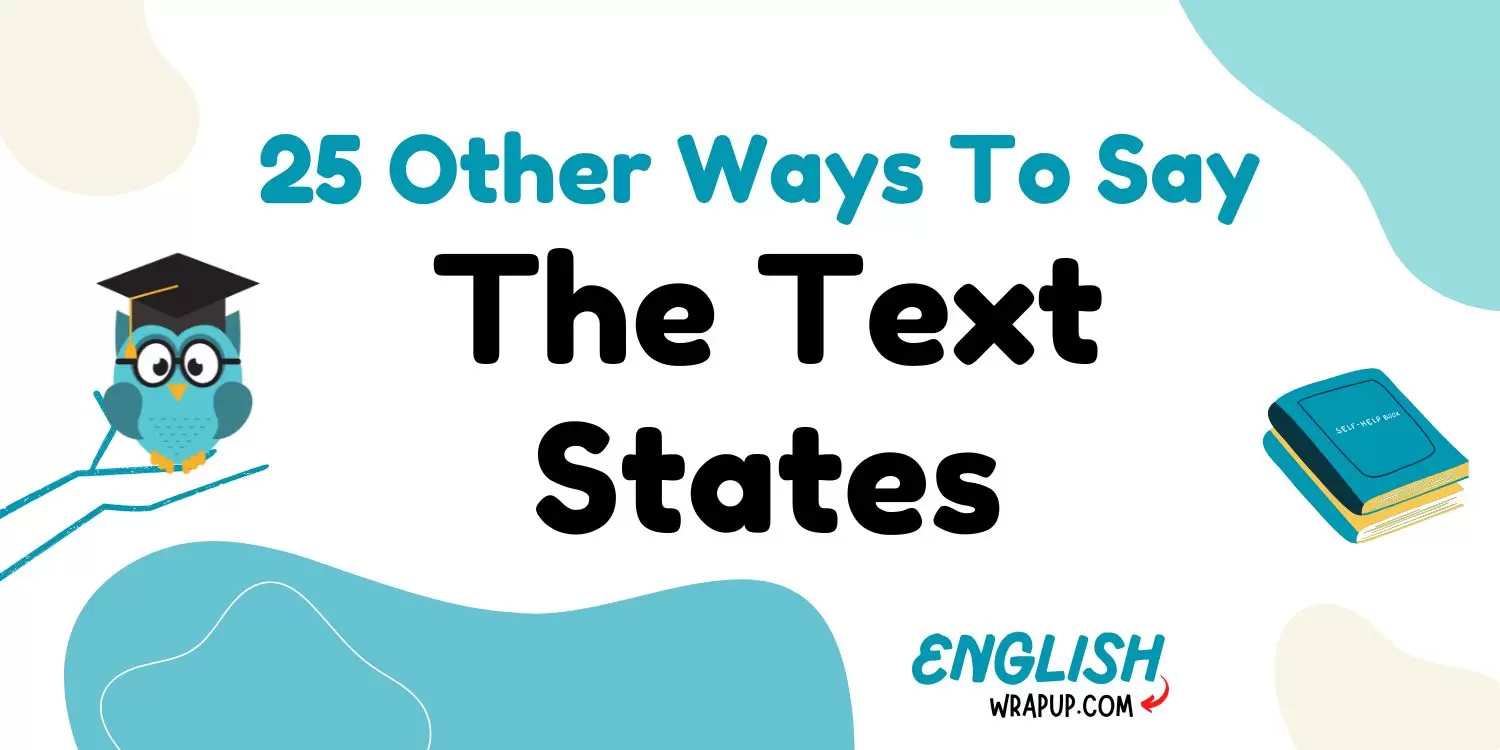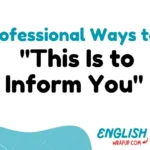When referring to information presented in a text, it’s essential to vary your language to keep your writing engaging. Here are 25 alternative phrases to use instead of “The text states,” each offering a unique way to convey the message:
Is It Professional to Say “The Text States”?
Yes, saying “The text states” can be professional and appropriate, particularly in formal or academic contexts where you are referencing specific information or quotes from a written source.
It demonstrates clarity and precision in your communication, indicating that you are directly citing information from the text rather than expressing your interpretation or opinion.
This phrase is commonly used in research papers, reports, presentations, and other formal documents to attribute information to its source accurately.
Using phrases like this can enhance the clarity and professionalism of your communication.
What to Say Instead of “The Text States”
- The text mentions…
- The text asserts…
- The text declares…
- The text affirms…
- The text contends…
- The text reports…
- The text claims…
- The text announces…
- The text communicates…
- The text conveys…
- The text expresses…
- The text reveals…
- The text indicates…
- The text suggests…
- The text implies…
- The text highlights…
- The text emphasizes…
- The text underscores…
- The text points out…
- The text notes…
- The text observes…
- The text remarks…
- The text discloses…
- The text unveils…
- The text presents…
The text mentions…
Using “The text mentions” implies that the information is brought up or referenced within the text.
Example: “The text mentions several key points regarding climate change.”
The text asserts…
When you say “The text asserts,” you suggest that the information is stated with confidence and conviction.
Example: “The text asserts that technology has revolutionized modern communication.”
The text declares…
To use “The text declares” is to indicate that the information is stated in a formal or definitive manner.
Example: “The text declares that all citizens have the right to vote.”
The text affirms…
Saying “The text affirms” suggests that the information confirms or validates a particular statement or idea.
Example: “The text affirms the importance of regular exercise for maintaining good health.”
The text contends…
When you use “The text contends,” you imply that the information presents a viewpoint or argument.
Example: “The text contends that globalization has both benefits and drawbacks.”
The text reports…
To say “The text reports” indicates that the information is presented as factual or based on research or observations.
Example: “The text reports the findings of a recent study on consumer behavior.”
The text claims…
Using “The text claims” suggests that the information makes a statement that may require further verification or evidence.
Example: “The text claims that this new product is the most effective on the market.”
Read Also: Other Ways to Say “This Quote Shows”
The text announces…
When you say “The text announces,” you imply that the information is presented in a formal or official manner.
Example: “The text announces the launch of a new initiative to combat poverty.”
The text communicates…
Saying “The text communicates” suggests that the information effectively conveys a message or idea.
Example: “The text communicates the author’s passion for environmental conservation.”
The text conveys…
To use “The text conveys” implies that the information effectively communicates a particular message or feeling.
Example: “The text conveys a sense of urgency regarding climate change.”
The text expresses…
When you use “The text expresses,” you suggest that the information communicates a particular sentiment or viewpoint.
Example: “The text expresses the author’s dissatisfaction with current political policies.”
The text reveals…
Saying “The text reveals” indicates that the information discloses or unveils something previously unknown.
Example: “The text reveals new insights into the behavior of certain animal species.”
Read Also: Other Ways to Say “Happy Sunday”
The text indicates…
Using “The text indicates” suggests that the information points to or suggests a particular conclusion or direction.
Example: “The text indicates a correlation between diet and overall health.”
The text suggests…
To say “The text suggests” implies that the information proposes or hints at a particular idea or interpretation.
Example: “The text suggests that there may be alternative solutions to the problem.”
The text implies…
When you use “The text implies,” you suggest that the information hints at or suggests something indirectly.
Example: “The text implies that there are hidden motives behind the decision.”
The text highlights…
Saying “The text highlights” indicates that the information emphasizes or brings attention to a particular aspect or point.
Example: “The text highlights the importance of teamwork in achieving success.”
The text emphasizes…
Using “The text emphasizes” suggests that the information stresses or underscores a particular idea or concept.
Example: “The text emphasizes the need for effective communication in leadership roles.”
The text underscores…
To say “The text underscores” implies that the information emphasizes or reinforces a particular point or argument.
Example: “The text underscores the importance of environmental conservation efforts.”
The text points out…
When you use “The text points out,” you suggest that the information draws attention to or highlights a specific detail or issue.
Example: “The text points out potential risks associated with the new technology.”
The text notes…
Saying “The text notes” indicates that the information makes a particular observation or comment.
Example: “The text notes the significance of historical events in shaping societal norms.”
The text observes…
Using “The text observes” suggests that the information makes a careful examination or assessment of a situation or phenomenon.
Example: “The text observes a shift in consumer preferences towards sustainable products.”
The text remarks…
To say “The text remarks” implies that the information makes a comment or observation about a particular topic or issue.
Example: “The text remarks on the changing dynamics of the global economy.”
The text discloses…
When you use “The text discloses,” you suggest that the information reveals or divulges something previously unknown or confidential.
Example: “The text discloses details about the company’s upcoming expansion plans.”
The text unveils…
Saying “The text unveils” indicates that the information reveals or introduces something for the first time.
Example: “The text unveils a new approach to addressing climate change.”
The text presents…
Using “The text presents” suggests that the information introduces or offers something for consideration or review.
Example: “The text presents a comprehensive analysis of the current economic situation.”
Final Thought:
By using a variety of phrases to convey the same idea, you can keep your writing fresh and engaging while effectively communicating the message contained within the text.

I’m Olivia Martinez, the educational mind behind “English WRAP Up.” I’ve had a blast teaching and grading English tests like TOEFL, IELTS, BULATS, FCE, CAE, and PTEG. At English WRAP Up, we’re dedicated to turning your exam preparation into a success story. Let’s make your English skills shine—join me in the educational journey at English WRAP Up!



